The rise of generative AI has sent ripples through the insights industry. This technology has become a point of contention: optimism and skepticism, highlighting the dichotomy between embracing innovation and preserving traditional jobs and skills. Despite the differing viewpoints, there’s a collective acknowledgment from most professionals in the industry that generative AI is reshaping our landscape.
In the Know: A Study by KJT and Voiceform
KJT, in partnership with Voiceform, completed a series of online interviews among members of the Insights industry. We sought to understand how insights professionals feel about generative AI and their perceptions of the outlook of this groundbreaking technology.
We gathered a diverse set of responses ranging between end clients, research agencies, and ResTech providers. We used Voiceform’s voice collection and smart probing features to gather rich insights. This allowed respondents to answer in their own way, with their own voice. All respondents were also given the option to respond with text instead of audio, if they preferred to have their input, but not their voice incorporated into the analysis.
Where Do We Stand? The Current State of Generative AI Adoption
The adoption levels of generative AI paint a picture of cautious implementation. Most believe they currently have moderate adoption of generative AI. This signifies they use it for several tasks/projects, but not to full the potential. Yet there is substantial limited adoption and even some who perceive their adoption to be advanced. These findings highlight the varying levels of adoption and utilization of generative AI among teams, indicating potential growth opportunities in the market.
Thinking ahead to 12 months from now, respondents are generally split between those who believe they will have a moderate and advanced (critical component of day-to-day tasks) adoption of generative AI. Yet, about one and ten predicted they would still have limited adoption in 12 months.
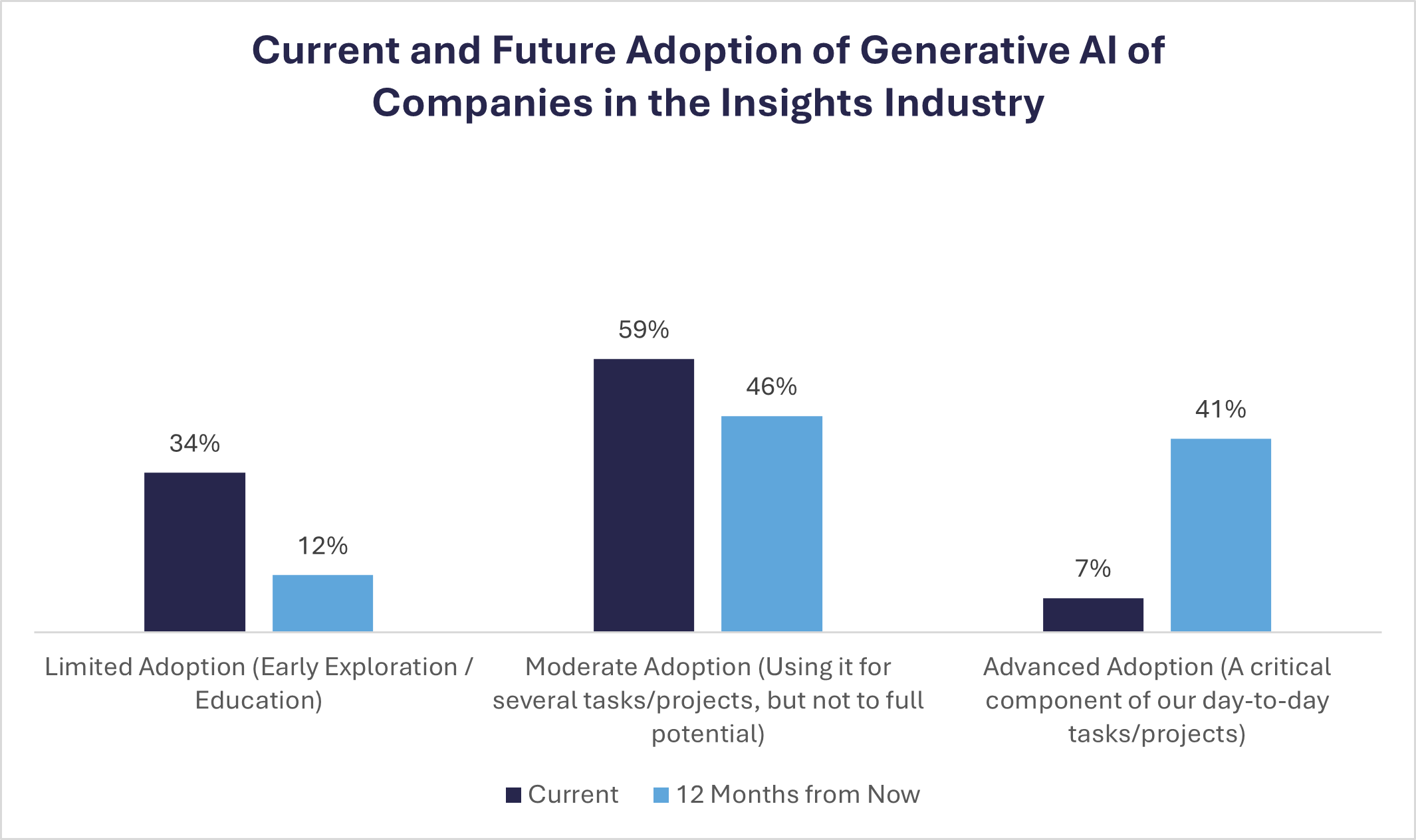
Critically, respondents expect their company’s uptake to increase substantially over the next year. For as much as many in the industry may feel overwhelmed and exhausted by the volume of generative AI discourse, the generative AI buzz is not only persistent, but also gaining decibels.
The Emotional Impact of Generative AI
Cautious excitement best encapsulates the prevailing sentiment toward generative AI, with shares of nervousness and realism as well. On the one hand, the use of generative AI may streamline tasks or output, but on the other, there is concern about the quality of information and general misuse of generative AI.
We’ve identified three distinct camps within the industry.
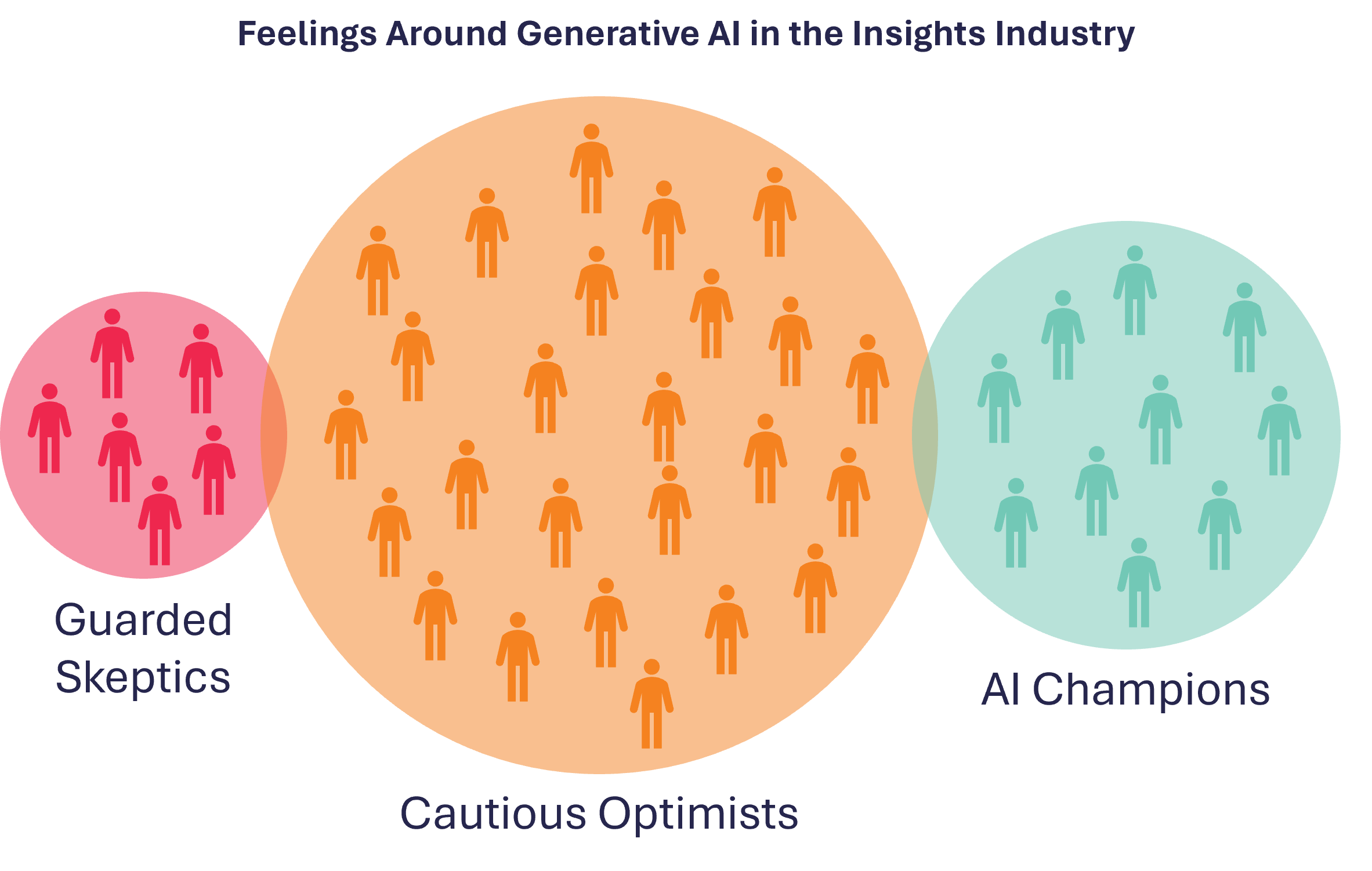
There is a group of insights professionals who we have termed the “AI Champions.” These are the people who are filled with excitement and are leading the charge for both their organizations and the industry. As one respondent put it, generative AI has “the ability to routinize mundane and repetitive tasks so the humans can use their brain power to the maximum potential.” They see the vision for what this technology can do for themselves and for others and, in general, are actively working towards achieving that goal.
This group highlights generative AI’s key benefits such as time savings and improving efficiency/productivity. They believe generative AI has the ability to spur creativity by generating ideas, builds out ideas faster, and makes work easier. Many of these professionals have already seen benefits from generative AI – the technology isn’t just a hypothetical, but it’s leading to better outcomes.
On the other side, there is a relatively smaller, but certainly not inconsequential group of “Guarded Skeptics.” These professionals are less sure of the benefits of generative AI and filled with caution, anxiety, and/or fear around its use. Some respondents express caution and believe that human intelligence is still necessary for making connections and uncovering real insights. The greatest fears raised by generative AI are around replacing what humans are doing today. This includes replacing jobs, strategic and critical thinking, opportunities for growth (especially among those who are entry level), and a generally decline in employee quality and adaptability.
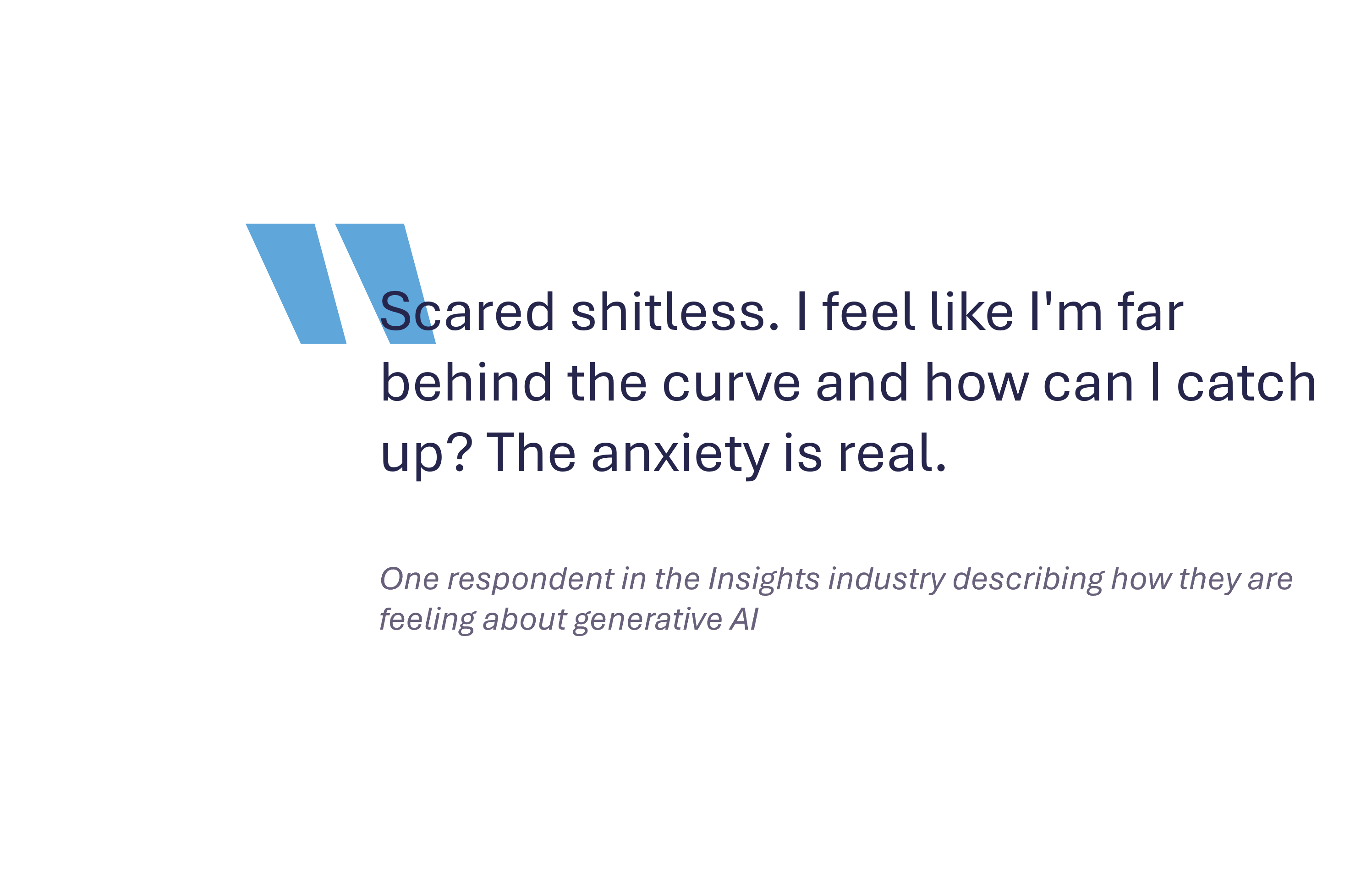
This group may even be a larger, proportionally, in the real world. Given the potential of response bias to a survey about generative AI, these individuals may have been less likely to respond to the survey than those who are more interested in the topic.
In between is a group of “Cautious Optimists” that represents more than half of the industry. These professionals typically lead with excitement and interest in generative AI, but also mention significant worries about its use.
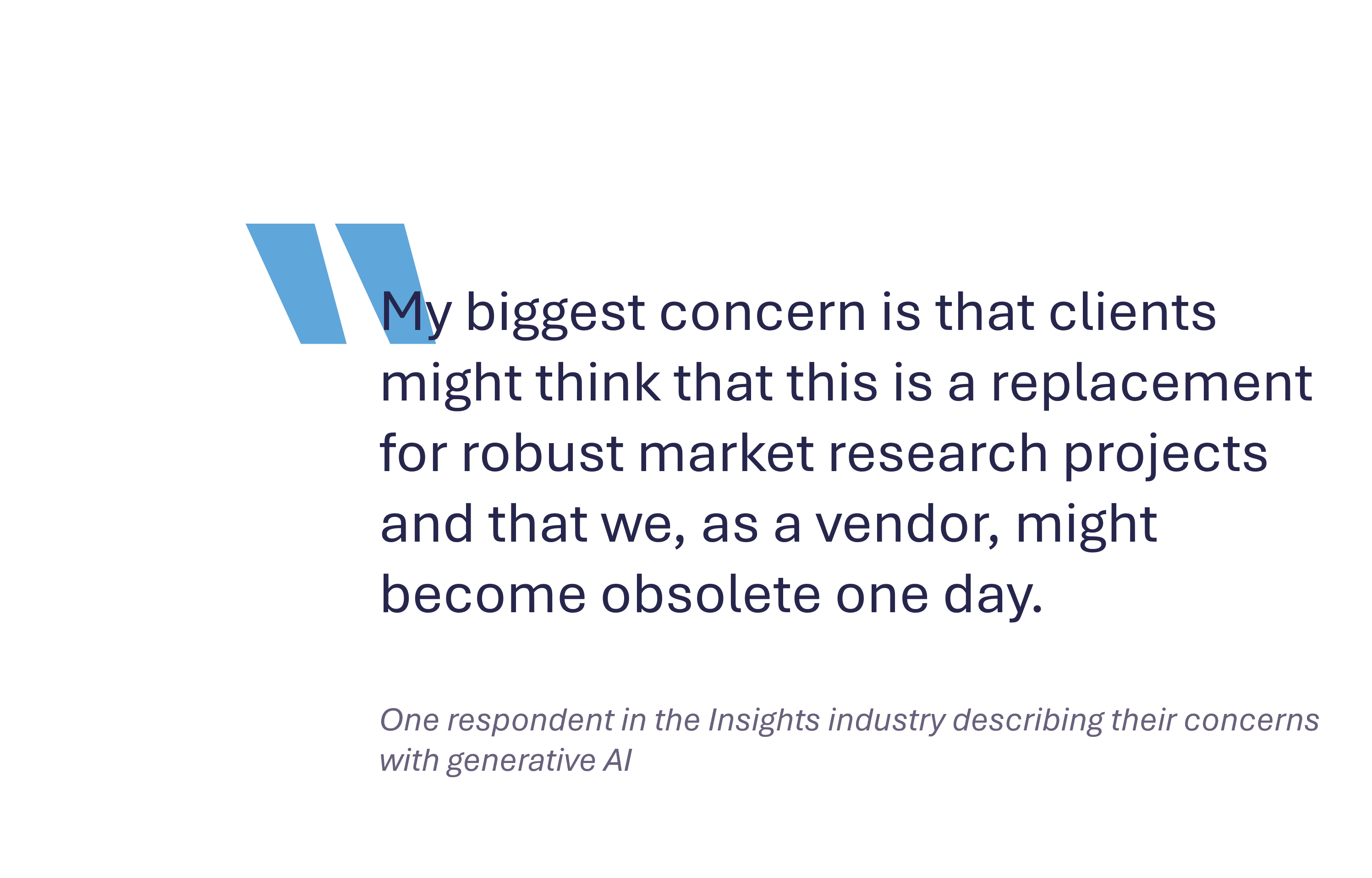
This group often raises concerns about the accuracy and validity of the data. One major concern is the reliability and accuracy of the data used by generative AI, with worries about incorrect information and biased models. It’s not always clear how generative AI arrives at its answers, given it is somewhat of a black box to the end user. Although OpenAI just announced a significant improvement in the GPT-4 model, some are concerned about the lack of up-to-date data available when using ChatGPT.
Another large area of concern is around the loss of creativity and individual thought. If many people are using generative AI, it has the potential for group think and loss of original thought.
One respondent told us that “I worry that there won’t be as much incentive for original thought/content creation.” This is an astute observation. In fact, a recent study demonstrated that generative AI increased creativity at the individual level by 40%, but at the team-level, it decreased creativity by 41% (reference).
Generative AI and the Future of the Industry
Most believe that generative AI has the potential to significantly impact the research and insights industry.
While individual respondents primarily provide one or two ideas each, the collective view they present suggests a significant transformation, ultimately driving the evolution of our research processes.
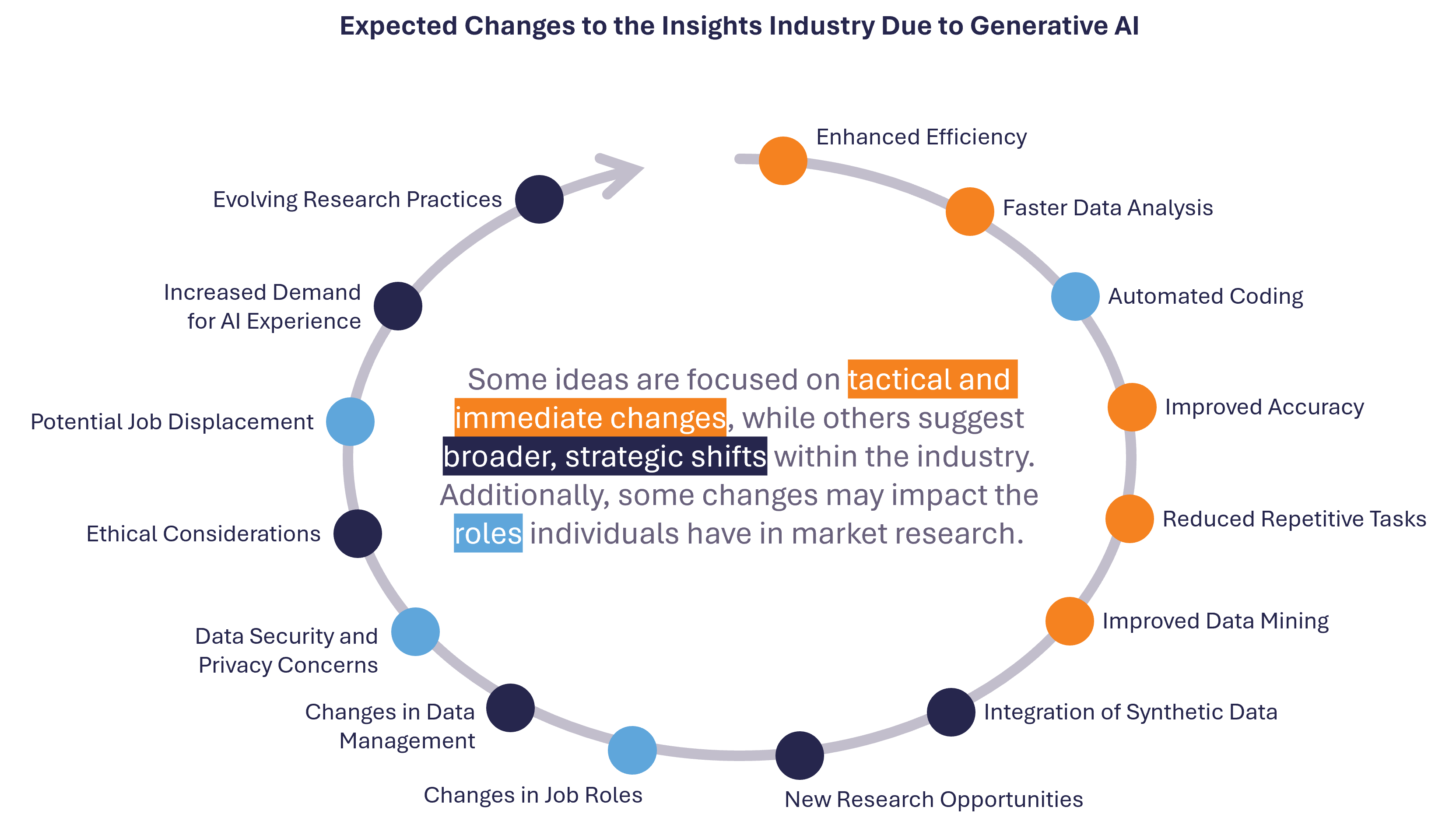
Thinking ahead to 12 months from now, some insights professionals believe that simple tasks will be automated, allowing researchers to focus on more complex tasks. Instant topline reports generated post qualitative research may become the norm. Coding, reporting, data analysis, and survey/questionnaire design are areas that will likely be improved.
These smaller, more tactical shifts will be impactful; however, broader, strategic shifts are likely as well. In particular, generative AI will change how data are collected and managed. Synthetic data, perhaps the most controversial aspect of generative AI among insights professionals, may completely disrupt the entire industry.
Yet, while there may be a shift towards faster and cheaper research, but there remains a need for in-depth analysis and fresh thinking that may not be possible with generative AI alone. It will be important for the industry to ensure professionals are balancing the efficiency gained with the depth of insight. Watered down insights pose a risk to end client decision making and have the potential to dilute the value of the industry as a whole.
Guidance for Companies Navigating Generative AI
The most prevalent idea that comes through in this research is that those in the Insights industry should embrace AI.
Many recommendations are not unlike those suggested when computers or the Internet were first used, although the speed of advancement of AI and adoption of technology may necessitate faster adaptation.
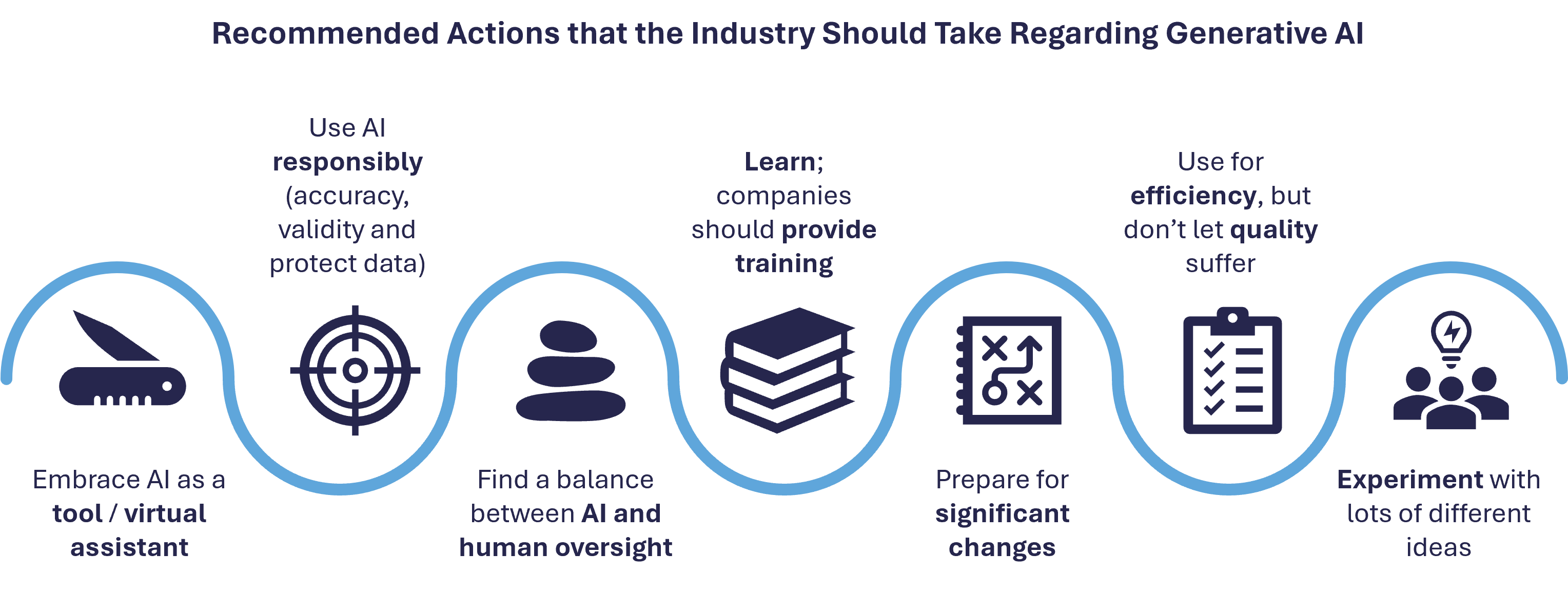
Overarchingly, professionals highlight the importance of embracing AI as a tool that requires human oversight to balance efficiency and quality, identifying the best use cases through education and experimentation. They mention the importance of being open-minded and ensuring they are not thinking of a generative AI tool as a replacement, but as a complement to human researchers and proven tools.
Oftentimes, respondents mention the importance of experiential learning. The best next step for anyone in the industry is simply to try different tools and alternative ways of using current tools with AI.

Some professionals explicitly highlight the importance of responsible AI. Data must be kept confidential, and all output needs to be reviewed to ensure accuracy (e.g., no hallucinations). These recommendations are in line with work being undertaken by industry associations such as the Insights Association and ESOMAR. These groups’ important work will help set the tone and develop norms for the entire industry around ensuring appropriate standards are in place.
Acknowledgements
Many thanks go out to Anne Wilber for analyzing these data and contributing to this report and Philip Brook and the Voiceform team for their collaboration. Plus, a huge thank you to all who participated in this research effort – we could not have done it without you!
You can learn more about the Voiceform data collection platform from their website.
Authors
Dan Wasserman
Chief Operating Officer and Head of AI Solutions
Dan Wasserman is KJT’s COO, leading the integration of generative AI into client solutions to drive innovation as part of Sparq Intelligence. With expertise in compliance, operations, and analytics, he transforms complex data into actionable insights. Dan values collaboration with KJT’s teams to help clients design better products and services.
Anne Wilber
Research, Associate VP
As an intuitive and thoughtful moderator, Anne’s innate curiosity fuels her ability to uncover nuanced insights that result in impactful outcomes and strategic value. Her leadership ensures projects are executed with precision and purpose. A collaborative partner, her approach fosters lasting partnerships, making her a trusted resource in research.
Ready to integrate generative AI into your next research study?
Get in touch with our team today!


